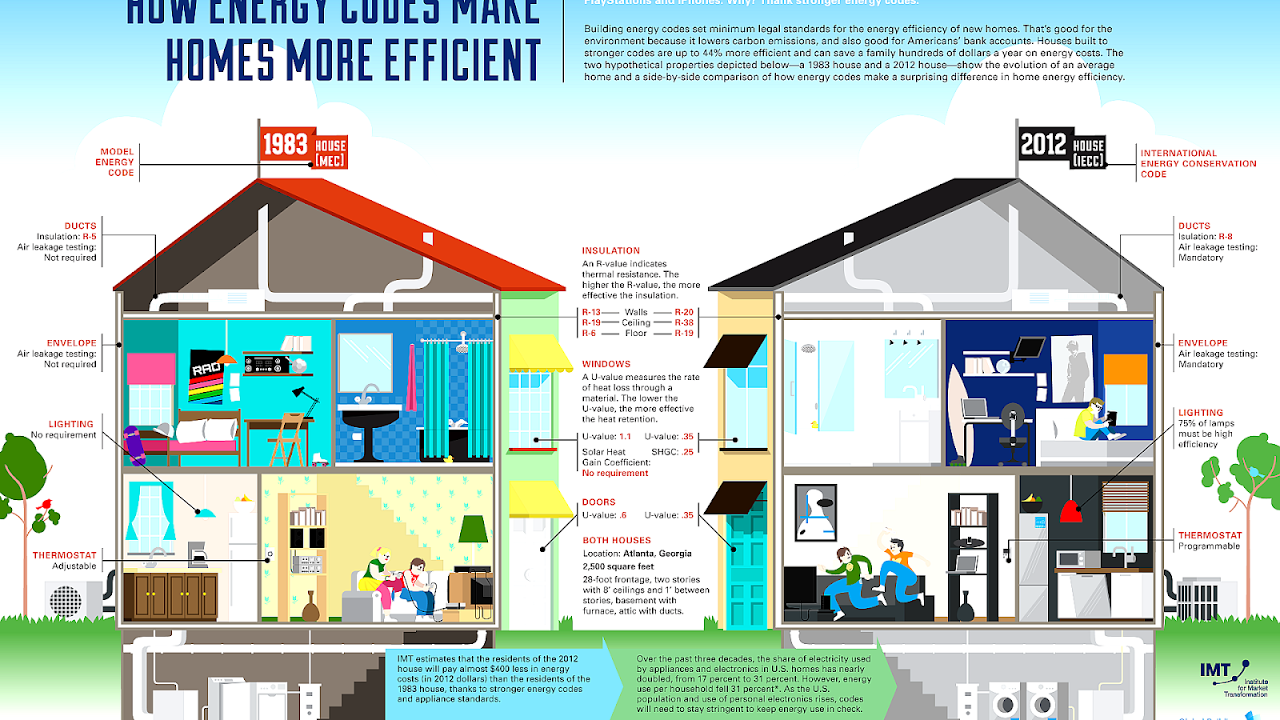
The United States building codes related to energy are energy codes and standards that set minimum requirements for energy-efficient design and construction for new and renovated buildings that impact energy use and emissions for the life of the building. Buildings account for 39% of United States energy use, two-thirds of electricity, and one-eighth of water. With buildings being such a main source of energy usage in the United States, along with the surrounding issues associated with high energy usage it is imperative that buildings abide by codes to ensure efficiency. Using more efficient methods and materials upfront when constructing the buildings will help to cut down on energy usage. There are building energy codes for both commercial and residential buildings.

Maps, Directions, and Place Reviews
United States building codes overview
In the USA the main codes are the International Commercial or Residential Code [ICC/IRC], electrical codes and plumbing, mechanical codes. Fifty states and the District of Columbia have adopted the I-Codes at the state or jurisdictional level.
New building code initiatives can sometimes be controversial and generate debate about the costs versus the benefits. In 2009, the 2009 International Residential Code (IRC) was updated to include a requirement of sprinklers in all new one- and two-family residences, including townhouses, which generated a varied response by states which can choose whether to adopt the update. As of 2010, several states had declined to update their codes, with California and Pennsylvania as the two who adopted the change.
Energy Code Video
Energy codes
There are 3 different kinds of building codes: private sector, federal sector, and international. The private sector codes are associated with state and local jurisdiction. States and local jurisdictions have different energy codes that they follow based on climate, geography, and many other contributing factors. The two primary baseline codes for the private sector are the International Energy Conservation Code (IECC), and the ANSI/ASHRAE/IESNA Standard 90.1 energy standard for Buildings Except Low-Rise Residential Buildings (ASHRAE 90.1). States and local governments adopt and enforce these energy codes. The standards are published by national organizations such as ASHRAE. The International Code Council (ICC) develops the codes and standards used to construct residential and commercial buildings, including homes and schools. Within the ICC is the IECC which is a subset of the ICC. The IECC is a model energy code, but it is written in mandatory, enforceable language, so that state and local jurisdictions can easily adopt the model as their energy code. The IECC references several ASHRAE Standards, in particular the ASHRAE 90.1 for commercial building construction.
State-by-state adoption
When states adopt building code updates, federal laws may affect these regulations. For example, the Energy Policy and Conservation Act generally prohibits regulations stricter than the IECC, unless specific exceptions are met.
In 2010, the American Recovery and Reinvestment Act included provisions to incentivize states to update their ASHRAE building codes.
The nonprofit Building Codes Assistance Project (BCAP) is aimed at improving building codes across the country, and produces diagrams showing adoptions across the country.
Cost savings
The National Institute of Standards and Technology (NIST) produced state by state estimates of potential savings from updating energy codes due to improved energy efficiency in 2013.
Federal codes
Federal sector energy building codes are nationwide and must be followed by every state and local jurisdiction for federal buildings, meaning buildings constructed by the federal government, notably including public housing. Federal commercial buildings must abide by the final rule established in 2007 based on ANSI/ASHRAE/IESNA Standard 90.1-2004. This final rule applies to new Federal commercial and multi-family high-rise residential buildings. The final rule is based on an interim final rule with a few changes based on public comment. The new changes include:
- Clarifying applicability of the new Federal building standards
- Clarifying the distinction between a "new" building and a major renovation "new Federal building" specifying that a building is a new building if it is completely replaced from the foundation up
- Including a minor modification to permit energy efficiency better than the maximum level that is cost effective
- Excluding process loads (e.g., medical or industrial equipment) from the energy savings metric and establishing definitions of "receptacle load" and "process load."
With regard to public housing and FHA-insured housing, the United States Housing and Urban Development (HUD) agency sets minimum energy codes.
Proposals
In 2009, the American Clean Energy and Security Act, aimed at addressing climate change, was passed by the House, but ultimately failed to be voted on in the Senate. It included provisions to improve building codes, which generated some controversies and misunderstandings.
Source of the article : Wikipedia








EmoticonEmoticon